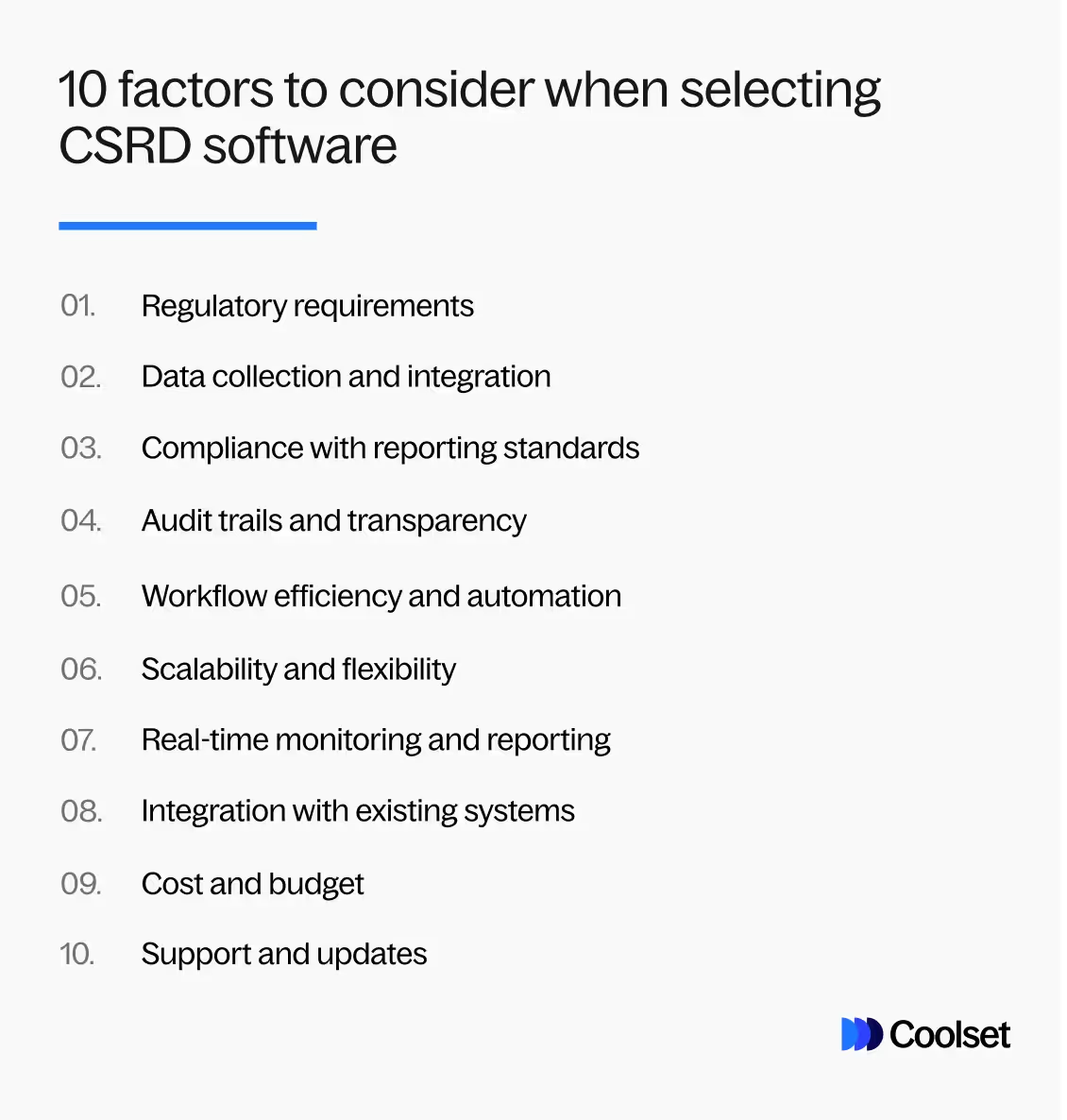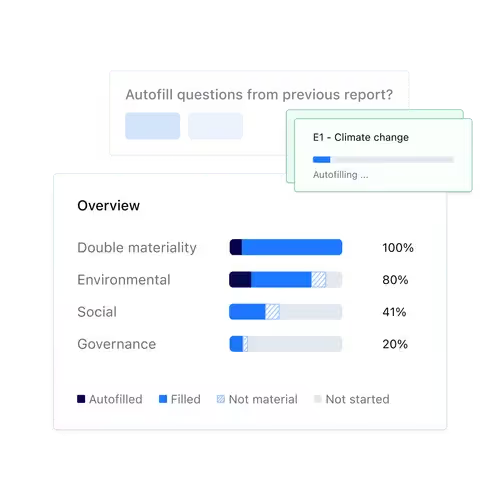Disclaimer: Latest EUDR developments
On 21 October, the European Commission proposed targeted changes to the EU Deforestation Regulation (EUDR). These adjustments aim to make the rollout smoother without changing the regulation’s overall goals.
Key points from the proposal:
We're closely monitoring the development and will update our content accordingly. In the meantime, read the full explainer here.
Transparency around corporate emissions and sustainability practices is becoming both an expectation and a requirement for thousands of companies across Europe.
With the Corporate Sustainability Reporting Directive (CSRD) deadlines approaching fast, businesses of all sizes are racing to meet new regulatory standards. This can feel like a daunting task, especially with the complexity of reporting requirements.
Whether you're new to sustainability reporting or just looking to streamline the process, having the right CSRD software in place is crucial. This guide will walk you through why you need CSRD software, what it does, and how to choose the best solution for your business.
Many businesses—around 55% according to a recent EY study—still rely on spreadsheets to manage ESG data. But with data quality cited as one of the biggest barriers to effective reporting, it’s clear that traditional tools can’t keep up with today’s reporting standards.
CSRD software is a must-have for handling the directive’s complex requirements, which involve tracking over 1,100 data points across 12 categories. Doing this manually in spreadsheets is not only time-consuming but also prone to errors.

A good CSRD tool automates key tasks—from data collection to reporting—making the process more efficient and accurate while helping you focus on the most relevant sustainability issues.
As customers, investors, employees, and regulators demand greater corporate transparency, CSRD software helps businesses meet those expectations and improve environmental performance.
By switching to CSRD software, companies can centralize their ESG data, reduce errors, and produce audit-ready reports, all while gaining better insights to reduce emissions.
Businesses use CSRD software to simplify every part of their sustainability reporting process, making it easier to meet the requirements of the CSRD. Here’s are some of the capabilities you can expect:

Now that we’ve covered why CSRD software is important and what it’s used for, here are the 10 factors to keep in mind when picking the right tool for your business:
First and foremost, your CSRD software must ensure compliance with the European Sustainability Reporting Standards (ESRS)—the governing framework for CSRD.
A core element of the CSRD is the double materiality assessment which helps you identify the relevant ESRS disclosures for your report. Look for features like built-in surveys to gather stakeholder insights, tools to calculate impact, risk, and opportunity scores, and a double materiality matrix to visualize the results.
Another useful feature is adaptive disclosure requirements. These automatically unlock only the disclosures relevant to your business based on your materiality assessment, so you can focus on what matters without being overwhelmed.
You should also choose a tool that generates audit-ready reports in .XBRL format, the mandatory format for CSRD filings. Tools like Coolset also offer access to a network of vetted auditors to help speed up the limited assurance process.
Lastly, look for tools that stay up-to-date with evolving regulations so you’re always compliant.
CSRD reporting involves collecting Scope 1, 2, and 3 emissions data from various sources across your business, including your internal operations and supply chain.
With data quality reportedly the biggest barrier to ESG investing, it's important to opt for CSRD software that automates the data collection and validation process.
Instead of manually gathering data from different departments or systems, the right software integrates with your existing tools (like ERP or financial systems) and automatically pulls in relevant ESG data. This reduces manual work, lowers the risk of errors, and ensures your data is consistent and complete.
When selecting CSRD software, ensure it follows recognized carbon accounting standards like the Greenhouse Gas Protocol (GHG Protocol). This guarantees your carbon data is reliable and meets regulatory expectations.
You should also check if the software itself is certified by reputable environmental organizations. This adds a layer of credibility to your CSRD reporting.
For example, Coolset’s carbon management methodology is TÜV Rheinland certified for Scope 1-3 measurements under the GHG Protocol. This ensures that Coolset’s software meets strict standards for accuracy and reliability, giving you confidence that your CSRD reporting will meet regulatory requirements.
Under the CSRD, your sustainability report needs to pass an audit. This means an independent third party will verify your materiality assessment, its results, as well as your documentation on all ESG topics.
A common mistake businesses make is using multiple spreadsheets and documents to manage this data. This scattered approach makes it difficult to track who worked on which parts of the report and how decisions were made—leading to headaches during the audit process.
To avoid this, choose CSRD software with built-in audit trails that track where your data came from, who handled it, and what changes were made. This makes verification smoother and helps you avoid additional audit costs.
{{custom-cta}}
The CSRD is a highly complex directive, and compliance can take a lot of time—up to 375 hours just to gather the necessary data for the first set of ESRS disclosures.
To make this process easier, it’s important to choose software that automates the most time-consuming tasks.
Look for tools that automatically pull data from different systems, only show the ESRS disclosures that are relevant to your business, and reuse information from previous reports to save you from starting over each time.
These automations can greatly reduce the time you spend preparing reports and ensure your data is accurate.
As your sustainability reporting progresses, so too will the amount of data you need to manage. This is especially true if regulations evolve or your company grows.
With tools like Excel limited by row and column sizes, you'll eventually outgrow traditional spreadsheets—not to mention the time it takes to work with such large files.
Look for CSRD software that can scale with your business, handle growing data needs, and adapt to new regulatory frameworks as needed.
Real-time access to sustainability metrics helps you respond to issues quickly and make informed decisions.
Choose software that provides real-time insights into sustainability metrics, like carbon emissions or water usage, allowing you to monitor progress continuously rather than waiting for the annual report. This improves transparency and keeps your business agile in its sustainability goals.
Many companies have carbon emissions data scattered across different systems - energy management, supply chain, travel, logistics, finance, and more. Each of these systems uses different metrics and formats, making it tough to get a clear picture of your carbon footprint.
To simplify this, look for CSRD software that integrates seamlessly with your existing tools. This will save you time, eliminate manual data transfers, and ensure your data is accurate and consistent across the board.
While functionality is crucial, make sure the software fits your budget. Look for scalable solutions that allow you to start with basic functionality and expand as your needs grow.
Just like anything new, achieving CSRD compliance means getting your head around a fresh set of rules and terminology. That’s why it’s important to look CSRD software that offers solid customer service to help you troubleshoot and stay on track.
It's also a plus if the provider offers resources like tutorials, webinars, or an online knowledge base to help you get the most out of the platform and stay updated on the latest CSRD requirements.
Take a peek at Coolset’s Academy for everything you need to know about mastering corporate sustainability.
Choosing the right CSRD software is key to meeting the EU's new sustainability reporting requirements. We hope this guide has helped you understand what to look for when picking the best CSRD software solution.
Coolset’s sustainability management and compliance software cover everything we've discussed above, from automating data collection to generating audit-ready reports, helping you streamline compliance and reduce errors.
Ready to see how it works? Try our interactive demo below and see how Coolset can keep you ahead of CSRD requirements.
{{product-tour-injectable}}
Speak to one of our sustainability experts
